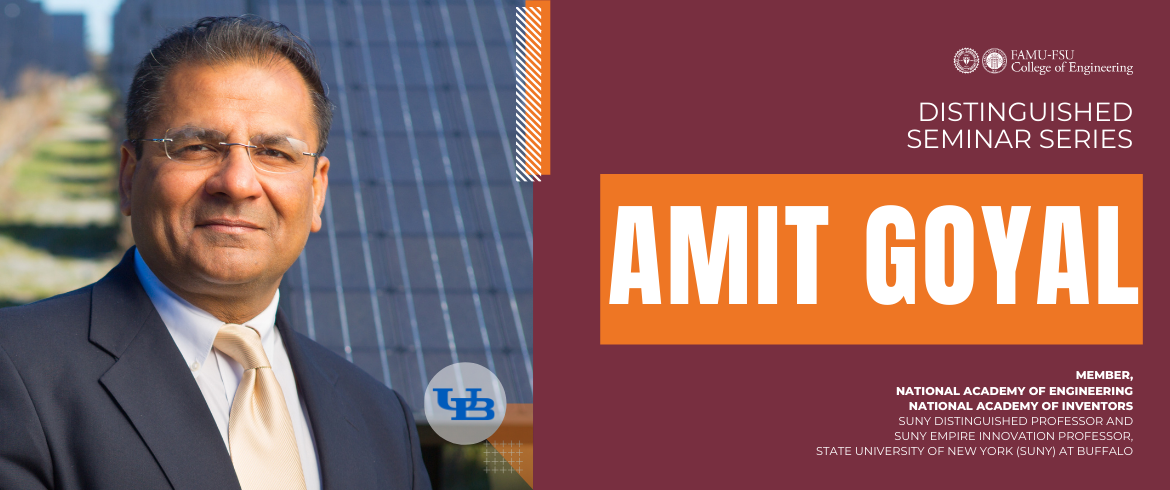
Distinguished Seminar Series: Amit Goyal, Ph.D.
“REBCO-based conductors for large-scale HTS applications: Exploring limits of performance in coated conductors”
A lecture by Amit Goyal, SUNY Distinguished Professor and SUNY Empire Innovation Professor at the State University of New York (SUNY) at Buffalo.
IN THIS Seminar:
Current status related to commercialization of three platform technologies will be discussed: (1) Rolling-Assisted-Biaxially-Textured Substrates; (2) LMOe-enabled IBAD MgO Substrates technology, for fabrication of kilometer-long HTS wires and (3) Phase Separation and Strain-driven Self-Assembly technology for creating controlled nanostructures in high-performance, kilometer-long wires. A majority of companies world-wide use one or more of these technologies for fabricating kilometer-long, high-performance, single-crystal-like HTS wires. However, the price/performance metric of coated conductors is not yet favorable for most large-scale applications. A key route to making the price/performance metric of HTS wires more favorable is to significantly enhance the critical current density, Jc (H,T) of coated conductors.
Engineered nanoscale defects within REBa2Cu3O7-δ (REBCO) based coated conductors are of great interest for enhancing the performance via vortex-pinning, especially in high-applied magnetic fields. We have previously reported excellent Jc’s and flux-pinning in YBCO films with self-assembled BZO columnar defects in the entire operating temperature regime from 4.2K-77K via correlated pinning from extended defects at mid to higher operating temperatures as well as collective pinning from oxygen point defects arising due to the local strain near YBCO/BZO interfaces at lower operating temperatures. We will report on our recent work to probe the limits of critical current density possible via defect engineering. We have obtained record values of critical current density, Jc, and pinning force, Fp, in REBCO coated conductors with self-assembled BZO nanocolumns fabricated using pulsed laser ablation. A Jc of ~ 190 MA/cm2 at 4.2K, self-field and ~ 90 MA/cm2, at 4.2K, 7T was measured. At 20K, Jc of over 150 MA/cm2 at self-field and over 60 MA/cm2 at 7T was observed. A very high pinning force, Fp, of ~ 6.4 TN/m3 and ~ 4.2 TN/m3 were observed at 7T, 4.2K and 7T, 20K respectively. These are the highest values of Jc and Fp reported to date. These results establish that significant performance enhancements are still possible and hence the associated reduction in costs that could potentially be realized in optimized, commercial HTS wires. In addition, we have experimentally confirmed the effect of local micro-strain resulting in oxygen point defects due to the large lattice-misfit between REBCO and BZO as well as the effect of Ca-doping in REBCO coated conductors to mitigate the microstrain. These results can help guide industry towards realizing significantly higher performance in commercial coated conductors or HTS wires.
About Dr. Goyal
Dr. Amit Goyal is a SUNY Distinguished Professor and SUNY Empire Innovation Professor at the State University of New York (SUNY) at Buffalo. He is a Member of the US National Academy of Engineering (NAE) and the National Academy of Inventors (NAI). He is a Fellow of AAAS, MRS, IEEE, APS, ASM, ACERS, IOP, WIF and WTN. He is a Member of the US National Materials & Manufacturing Board (NMMB) and has served on National Academy Committees for reviewing national initiatives, several national laboratory efforts, and developing national plans in various areas. He has co-authored over 360 publications and has 85 issued patents. An analysis of citations and papers published world-wide in the field of high-temperature superconductivity, between 1999-2009, conducted by Thompson-Reuters’s Essential Science Indicators (ESI), ranked him as the most cited author worldwide.
He is the Director of the Laboratory for Heteroepitaxial Growth of Functional Materials & Devices as well as the Director of the NYS Center of Plastics Recycling Research & Innovation at the University. He served as the Founding Director of the university-wide Institute on Research and Education on Energy, Environment & Water (RENEW) from 2015-21. He is an Emeritus Corporate Fellow at the Oak Ridge National Laboratory.
He has received numerous accolades including the presidential level DOE’s E. O. Lawrence Award in the inaugural category of Energy Science & Innovation. The US Department of Energy (DOE) Secretary on behalf of the President of the United States bestows the award. Selected additional honors include: TEN R&D 100 awards which are widely regarded as the “Oscars for Innovation” as well as the R&D Magazine's "Innovator-of-the-Year" award in 2010 for sustained innovations, and Three National Federal Laboratory Consortium (FLC) Awards for Technology Transfer. He was awarded the SUNY-Buffalo President’s Medal in 2019.
